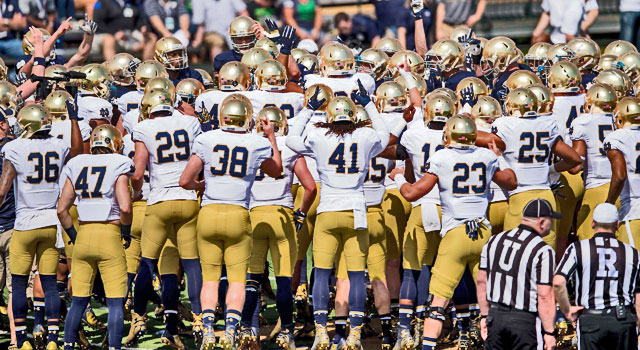

Notre Dame plays a real, live game this week, and to get you ready for Saturday’s 7:30 kickoff I’ve developed a little cheat sheet of some keys to the game and ultimately Notre Dame’s season long success, position by position.
Quarterback- Can Malik Zaire average 9 yards per passing attempt?
This is an offense that is built on explosiveness from all of the skill positions. They’ve got big play threats in receivers Will Fuller and Torii Hunter Jr., among others, running backs Tarean Folston and CJ Prosise, and tight end Alize Jones, who in his first fall camp has been making catches like this. They also have the ultimate playmaker at quarterback in Malik Zaire, who has shown the ability to make big plays with his legs and his arm. The knock on Zaire has always been his accuracy and has never been seen as a polished passer, especially in relation to departed quarterback, Everett Golson. However, the key to Zaire’s game will be quality, not quantity. With the threat of the run always looming in the minds of defenses, Zaire will have the opportunity to throw over the top of them to his speedy playmakers. In 2014, Marcus Mariota, the ultimate running/throwing threat, led the nation with 10 yards per attempt and Ohio State’s J.T. Barrett, also a running threat, came in at #4 with 9 YPA. By comparison, Golson, who can run the ball but never showed that as a preference, averaged 8.1 YPA. Notre Dame fans will lament Tommy Rees’s inability to get to the ball down field in 2013, yet he averaged 7.9 YPA that season. Golson didn’t push the ball down the field as much as he could have, and the deep field passing game is an area where Zaire can exceed his former counterpart. If he can that will set-up Notre Dame to be an extremely explosive team in 2015.
Running Back-Will CJ Prosise average 10 carries a game?
The two most successful running teams of the Brian Kelly era–2011 and 2012–featured a true time share at the running back position; first it was Cierre Wood and Jonas Gray, later Cierre Wood and Theo Riddick. In both of those seasons, Notre Dame featured two running backs who averaged double digit carries per game. That fell off the last two seasons with #2 backs George Atkinson averaging 7.7 carries a game in 2013 and Cam McDaniel averaging 5.9 carries per contest last year. Consequently, it was Tarean Folston or bust in 2014 and that led to a less than productive running attack and Notre Dame relying heavily on the pass. CJ Prosise is new to the running back position and figured to share back-up duties with Greg Bryant, who was later ruled ineligible, and is now the primary back-up to Folson. He is known as a speed back, but at 225 pounds he also has the size to get the ball inside on zone plays. It’s no secret that Notre Dame wants to run the ball more in 2015, if Prosise can hold up to 10 carries a game that takes some of the load off of Folston and Zaire, leaving both healthier and with fresher legs throughout the season, ultimately leading to better quality of production from all three players.
Wide Receiver-Will Torii Hunter Jr. become the clear #2 receiver?
Notre Dame has a clear #1 wideout in Will Fuller, who has already had a 1,000 yard season to go along with 15 touchdowns, but in 2015, Notre Dame lacked a viable #2 option at wideout. Corey Robinson and Chris Brown combined to catch 79 passes for 1,087 yards and 6 touchdowns, which is nice for one guy, but for the pair is a little under-whelming. Hunter Jr. has been the talk of fall camp with his athletic ability, his separation and overall playmaking skills. If he can emerge as a 50 catch 850 yard receiver out of the slot, that will force defenses to keep a safety in the middle of the field, giving Fuller more room to work outside and completely opening up the other side of the field giving Brown and Robinson free reign to do more things like this.
Tight End-Will one tight end emerge as the go-to guy?
Notre Dame has come to be known as tight end U in the last decade or so, sending multiple players to the NFL from that position. However, in that time, there has been a pretty clear “top guy” at the position and then that spot was passed. In Kelly’s time it’s gone from Rudolph to Eifert to Niklas to Koyack, each serving as the clear #1 for at least one season. This year Notre Dame is high on numbers–five players could see real playing time–but low on any single player who will carry the load. Durham Smythe is seen as the best all-around player of the group, but he has been injured for a good amount of fall camp. Freshman Alize Jones and sophomore Nic Weisher are seen as mainly receiving threats, while sophomore Tyler Luatua and senior Chase Hounshell are seen as the blocking group. While they can all serve a roll, some consistency needs to be shown out of this position, whether it’s in the rotations or one player stepping up as the go-to guy. Having a running group and passing group is fine, but it doesn’t do much in the way of disguising your plays.
Offensive Line-Will Notre Dame be able to run the ball for red zone touchdowns?
Notre Dame has had issues with red zone scoring seemingly since the beginning of the Kelly era. They were 45th nationally in touchdown percentage in 2014, 100th in 2013, 112th in 2012, and 28th in 2011. The dropoff in red zone production coincides with Notre Dame’s propensity to throw the ball close to the goal line rather than run. In 2015, 21 of the team’s 40 touchdowns in the red zone were on the ground, or 53%. In 2011, Notre Dame’s most efficient team in red zone touchdown production, Notre Dame ran the ball in 63% of the time, 20 out of 32 touchdowns. And this was with the immobile (plodding?) Tommy Rees at quarterback. By comparison, Pittsburgh, who finished 2nd in red zone touchdown percentage last season ran the ball for scores 31 times out of their 44 touchdowns, an impressive 70%. Of course, that’s not to say it’s the only way to be successful in the red zone–USC finished first nationally in red zone touchdown percentage and only ran the ball in 30 % of the time–but to be an efficient red zone team that primarily throws the ball you need an extremely efficient quarterback who doesn’t make mistakes. The aforementioned USC had Cody Kessler who had all of five interceptions last year and was 4th in quarterback rating. If Notre Dame is counting on Zaire to throw for scores in the red zone, where his ability to throw over top of the defense is taken away, they are likely to run into the same issues they’ve had in that area of the field in the past. Notre Dame’s offensive line is built to maul people and there is no greater need for it than in the red zone, where Notre Dame failed far too often last season.
Defensive Line-Can this unit keep opponents to under 3.5 yards a carry?
Notre Dame came in at 60th nationally in rushing defense in 2015, with opponents carrying it for 4.2 yards a pop and 171 yards per contest. Fans would have expected those numbers given the way the team finished the season and the general regard for the defensive performance last year. But a quick look at the defensive numbers in September and October of last season should give us hope for what this group can do, should they stay healthy, Jarron Jones’ injury notwithstanding. In September of last season Notre Dame to 3.3 yards a carry and 108 yards a game. And of course you’ll say “yeah, but those September teams weren’t exactly juggernauts?” Wait for it. In October of last season, against the likes of Stanford, North Carolina and Florida State, the defense ranked 10th nationally giving up 2.8 yards a pop and 95 yards a game. Against Navy the injuries started to mount, the sea parted and teams were running wild to the tune of 4.7 a carry and 244 painful yards. The 2015 defensive line is a year older, literally brought back everyone, added a blue-chip freshman and despite the loss of Jones can answer with a slimmer and more robust Daniel Cage at the nose tackle. Notre Dame’s secondary figures to be a significant strength this year, and teams are likely to try and run right at Notre Dame to get ahead of the chains. If the defensive line can hold up to the challenge and keep teams in 2nd, 3rd and long, that plays right into the hands of Brian VanGorder’s style of defense.
Linebackers-How will Jaylon Smith be utilized?
The Fighting Irish version of “where’s waldo” will be tracking where Smith lines up on a play to play basis. Brian Kelly had glowing praise for Smith during his Tuesday press conference, calling him by far their best defensive player. I’d take that a step further and call him the best player on the entire team. He is the guy who opposing fans are going to watch and think “I really wish that guy played for us.” His great strength is his versatility; he can play inside and take on guards and centers, he can play outside and cover receivers, and he’s got the speed to both play sideline to sideline as well as get after the quarterback. It is up to Brian VanGorder to use all of Smith’s vast skill set to move Smith around and keep opposing quarterbacks guessing as to where he is going to be and how he is going to attack the offense. In order for a team to be great, your best players have to play to the level of their talent, and there is no greater talent on defense, perhaps in the country, than Jaylon Smith.
Defensive Backs-Can Max Redfield become a playmaker at free safety?
In 11 starts last season, the sophomore safety was second on the team in tackles with 68, but only one of those came in the backfield, and he had as many interceptions, one, as he did ejections. He also only recorded 2 passes broken up, which is a pretty low number for a starting free safety. In fact, his most notable play last season was one that was flagged for a penalty (although it is also among the fan favorites). For the secondary in 2015 to reach it’s potential as the strength of the defense, Redfield has to be more of playmaker in the deep middle of the field. There has been a lot of talk about the growth of the junior safety from Brian Kelly and there is a belief in Notre Dame circles that Redfield was inhibited from making plays because of his confusion with his assignments and the burden of having to direct the secondary and getting them in position. Now that Redfield is in his second season in Brian VanGorder’s defense he should be more comfortable with the schemes and calls, as has been reported, and fans should expect to see a more confident player at the back end of the defense that showcases his range and athletic ability.
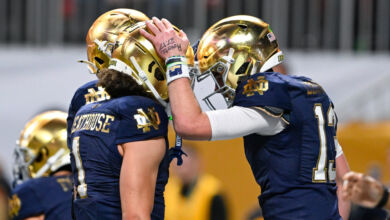
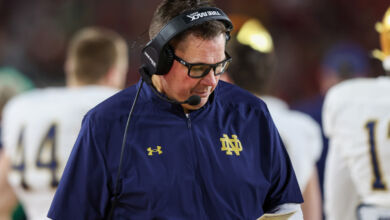
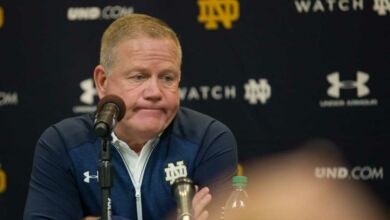
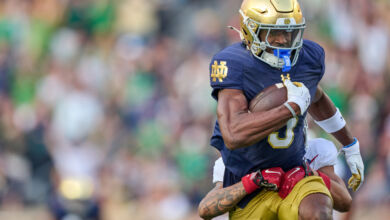
Time to play!